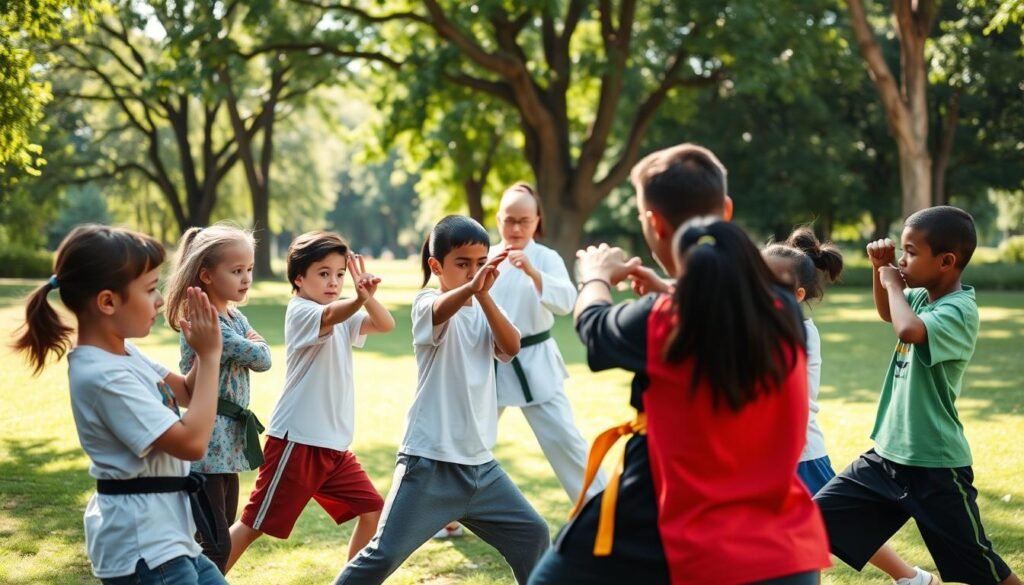Are suburban kids truly prepared for the challenges of urban environments? As they venture into the city, they may face unfamiliar situations that require more than just knowledge from textbooks. Urban survival and city navigation skills become essential for their safety and confidence.
Teaching street smarts to suburban kids is about equipping them with the ability to navigate complex city landscapes, understand social cues, and make informed decisions. It’s about empowering them to be aware of their surroundings and to trust their instincts.
Key Takeaways
- Understanding the importance of urban survival skills for suburban kids.
- Learning how to navigate city environments safely.
- Gaining confidence in making decisions in unfamiliar settings.
- Developing awareness of social cues and surroundings.
- Building trust in one’s instincts and judgment.
Why Suburban Kids Need Urban Awareness
Growing up in the suburbs can be a safe and nurturing experience, but it may not prepare kids for urban challenges. Suburban areas are often characterized by their tranquility and predictable environments, which can be quite different from the fast-paced and dynamic nature of city life.
The Sheltered Suburban Experience
The suburban lifestyle often shields kids from the complexities and unpredictabilities of urban environments. This sheltered experience can be beneficial in many ways, but it also means that suburban kids might not develop the necessary street smarts to navigate city streets confidently.
- Limited exposure to diverse cultures and lifestyles
- Less opportunity to develop situational awareness
- Potential lack of confidence in navigating unfamiliar areas
Real-World Challenges Beyond the Suburbs
When suburban kids venture into urban areas, they may face challenges such as crowded streets, complex public transportation systems, and diverse social interactions. Being aware of their surroundings and understanding how to interact with others in these environments is crucial.
Some of the real-world challenges include:
- Navigating through crowded areas without getting lost
- Understanding and using public transportation effectively
- Interacting with people from different backgrounds
Building Confidence Through Knowledge
Gaining knowledge about urban environments and how to navigate them can significantly boost a suburban kid’s confidence. By learning about urban awareness, kids can feel more prepared to handle the challenges they might face.
Key areas to focus on include:
- Understanding how to read maps and use navigation apps
- Learning about potential safety concerns and how to address them
- Developing skills to interact with strangers appropriately
Developing Street Smarts: Essential Skills for Today’s World
As suburban kids navigate their way through an increasingly complex world, developing street smarts has become an essential life skill. Street smarts encompass a broad range of skills and awareness that help individuals navigate urban environments safely and effectively.
Defining Street Smarts in Modern Context
In today’s world, street smarts are not just about avoiding danger; they’re about being aware of one’s surroundings, understanding social cues, and making informed decisions. Street smarts involve a combination of common sense, situational awareness, and the ability to adapt to new situations. This modern definition goes beyond traditional notions of street smarts, incorporating elements of emotional intelligence and social savvy.
The Psychology of Urban Environments
Urban environments can be overwhelming, with crowded streets, noise pollution, and a fast-paced lifestyle. Understanding the psychology behind these environments can help suburban kids better navigate them. The key is to be aware of one’s surroundings and to understand how people interact in these spaces. By being mindful of body language and social norms, kids can avoid unintended conflicts and stay safe.
Balancing Safety and Independence
One of the biggest challenges for suburban kids is balancing the need for safety with the desire for independence. Parents and guardians must strike a balance between protecting their children and giving them the freedom to make their own decisions. By teaching kids how to assess risks and make informed choices, we can help them develop the street smarts they need to thrive in today’s world.
| Essential Skills | Description | Benefits |
|---|---|---|
| Situational Awareness | Being aware of one’s surroundings | Enhanced safety, reduced risk |
| Social Skills | Understanding social cues and norms | Better interactions, fewer conflicts |
| Decision Making | Making informed decisions based on available information | Increased confidence, independence |
Mastering Situational Awareness
Being aware of one’s surroundings is the first step towards ensuring personal safety. Situational awareness is about being present and attentive to your environment, which is crucial for suburban kids venturing into urban settings.
The Importance of Being Present
Being present means focusing on your surroundings rather than being distracted by your phone or other factors. It’s about engaging with your environment and the people around you. This mindfulness helps in identifying potential risks early.
To be more aware, start by practicing mindfulness in your daily routine. Pay attention to the people around you, notice the exits and entrances in buildings, and be conscious of your belongings.
Recognizing Potential Threats
Recognizing threats involves understanding body language cues and environmental red flags. Being able to read these signs can help you avoid potentially dangerous situations.
Body Language Cues to Watch For
People who are being aggressive or confrontational often display specific body language, such as clenched fists, intense staring, or invading personal space. Being aware of these cues can help you take necessary precautions.
Environmental Red Flags
Environmental red flags include poorly lit areas, deserted streets, or any setting that makes you feel uncomfortable. Trusting your instincts about your environment is crucial for staying safe.
Practicing the “Color Code” Awareness System
The “Color Code” awareness system is a practical tool for enhancing situational awareness. It involves categorizing your state of awareness into different “colors” based on your level of alertness and preparedness. This system helps in developing a proactive mindset towards personal safety.
By mastering situational awareness, suburban kids can better navigate urban environments with confidence and safety.
Navigating Urban Environments Safely
Urban navigation requires a combination of skills, including reading maps and understanding safe routes. As suburban kids venture into cities, they need to be equipped with the knowledge to navigate safely and confidently.
Reading Maps and Using Navigation Apps
One of the fundamental skills for urban navigation is being able to read maps and use navigation apps effectively. This involves understanding map legends, recognizing landmarks, and using GPS technology to stay on track.
- Download maps for offline use to navigate without data.
- Use navigation apps like Google Maps or Waze for real-time traffic updates.
- Practice reading physical maps to understand spatial relationships.
Identifying Safe Routes and Areas
Knowing how to identify safe routes and areas is crucial for urban navigation. This includes avoiding areas with high crime rates, being cautious in isolated spots, and sticking to well-lit and populated routes.
What To Do If You Get Lost
If you get lost, stay calm and use your navigation tools to reorient yourself. Knowing how to find emergency meeting points and using landmarks can help you get back on track.
Emergency Meeting Points
Identify safe locations such as police stations, hospitals, or busy stores where you can seek help if lost.
Using Landmarks
Landmarks are essential for navigation. Recognize distinctive features like statues, buildings, or street art to help guide you.
By mastering these skills, suburban kids can navigate urban environments with confidence and safety.
Public Transportation Survival Guide
The ability to navigate public transportation with confidence is an essential street smarts skill. As suburban kids venture into urban environments, understanding how to use buses, subways, and rideshares effectively becomes crucial.
Understanding Transit Systems
To master public transportation, one must first understand the transit system in place. This includes familiarizing oneself with the network of buses and subways, their routes, and schedules. Many cities offer transit apps or websites that provide real-time information, making it easier to plan journeys.
Key aspects to understand include:
- Route maps and schedules
- Peak and off-peak travel times
- Transfer options between buses and subways
Safety Tips for Buses, Subways, and Rideshares
Safety is paramount when using public transportation. Here are some tips to stay safe:
For Buses and Subways:
- Be aware of your surroundings and keep an eye on your belongings.
- Avoid traveling alone in empty cars or at the end of the line.
- Follow the instructions of transit staff and signage.
For Rideshares:
- Verify the driver’s identity and the vehicle’s details before getting in.
- Share your trip details with a friend or family member.
- Sit in the back seat and avoid engaging in conversations that make you uncomfortable.
As
“The key to safe travel is being informed and aware of your surroundings.”
, a principle that guides many transit safety guidelines.
Handling Unexpected Situations
Despite the best planning, unexpected situations can arise. Knowing how to handle delays, cancellations, or other disruptions is vital.
Tips for handling unexpected situations include:
- Staying calm and assessing the situation.
- Having a backup plan, such as knowing alternative routes.
- Keeping important phone numbers handy, such as the transit authority’s customer service.
By being prepared and knowing how to navigate public transportation systems, suburban kids can confidently explore urban environments.
Smart Interactions with Strangers
Smart interactions with strangers are crucial for suburban kids to navigate urban settings confidently. As they venture into new environments, understanding how to engage with people they don’t know can make a significant difference in their safety and independence.
When to Help and When to Walk Away
Knowing when to assist someone and when to walk away is a vital skill. Suburban kids should be taught to trust their instincts; if a situation feels uncomfortable or suspicious, it’s okay to politely decline to help. For instance, if a stranger asks for directions, it’s perfectly fine to provide a general direction without engaging further.
Key considerations:
- Assess the situation: Is it safe to intervene?
- Trust your instincts: If it feels wrong, it’s okay to walk away.
- Be polite but firm: A simple “I’m not comfortable” can suffice.
Recognizing Manipulation Tactics
Urban environments can expose kids to various manipulation tactics. It’s essential to educate them on common scams and pressure techniques used by scammers.
Common Scams Targeting Young People
Young people are often targeted by scams that promise easy money or gifts. Suburban kids should be wary of such offers and understand that if it sounds too good to be true, it probably is.
Pressure Techniques to Be Aware Of
Scammers often use pressure tactics to create a false sense of urgency. Kids should be cautious of strangers who push them to make quick decisions or provide personal information.

Setting Boundaries Firmly but Politely
Teaching suburban kids to set boundaries is crucial. They should learn to say “no” firmly without being aggressive. Practicing assertive responses can help them feel more confident in their interactions.
Example scripts:
- “I’m not comfortable with that. I’m going to leave.”
- “No, thank you. I’m good.”
By mastering these skills, suburban kids can navigate urban environments more safely and confidently.
Recognizing and Avoiding Dangerous Situations
Recognizing and avoiding dangerous situations is a vital skill for kids transitioning from suburban to urban settings. As they navigate new environments, being aware of their surroundings can significantly reduce their risk of encountering trouble.
Reading Environmental Cues
One of the key aspects of staying safe is learning to read environmental cues. This involves being observant of the surroundings, such as noticing if an area seems deserted or if there are suspicious characters lurking around. Paying attention to the overall atmosphere of a place can provide valuable insights into potential safety risks.
Trusting Your Instincts
Trusting your instincts is equally important. If a situation or place feels off, it’s crucial to listen to that inner voice. Instincts are a powerful tool that can help individuals avoid potentially hazardous situations. Encouraging kids to trust their gut feelings can be a lifesaving strategy.
Exit Strategies for Uncomfortable Scenarios
Having an exit strategy is vital when faced with an uncomfortable or potentially dangerous situation. This involves knowing how to leave a place quickly and safely. There are several tactics that can be employed, such as creating distractions or finding safe havens.
Creating Distractions
Creating a distraction can be an effective way to divert attention and escape from a threatening situation. This could be as simple as making a loud noise or causing a commotion to draw people away from the area. Teaching kids how to create distractions safely can provide them with an additional layer of protection.
Finding Safe Havens
Identifying safe havens is another crucial exit strategy. This could be a nearby store, a police station, or a trusted neighbor’s house. Knowing where to find help can make a significant difference in an emergency. Mapping out safe locations in advance can be a proactive step in ensuring safety.
By teaching kids to read environmental cues, trust their instincts, and develop exit strategies, we can empower them with the skills needed to avoid dangerous situations. These are essential life skills that will serve them well beyond their urban adventures.
Basic Self-Defense Strategies for Kids
Empowering children with basic self-defense strategies can significantly enhance their personal safety. Teaching kids how to protect themselves is not just about physical techniques; it’s also about awareness, confidence, and knowing when to seek help.
Prevention as the First Line of Defense
Prevention is the most effective self-defense strategy. Teaching kids to be aware of their surroundings and to trust their instincts can help them avoid potentially dangerous situations. It’s essential to educate children on how to read environmental cues and recognize potential threats.
Simple Techniques Anyone Can Learn
Kids can learn simple yet effective self-defense techniques that can help them protect themselves. Basic physical techniques, such as breaking free from grabs or holds, can be taught in a way that’s fun and engaging for kids. It’s also crucial to teach kids how to assertively say “no” and set boundaries.

When and How to Seek Help
Knowing when and how to seek help is a critical aspect of self-defense. Kids should be taught to identify safe adults, such as police officers, teachers, or family friends, whom they can trust in case of an emergency. It’s also important to teach kids how to use technology, like calling 911 or using a safety app, to get help when needed.
Using Technology for Safety
Kids can use technology to enhance their safety. Safety apps and devices can provide an added layer of protection, allowing kids to quickly alert authorities or trusted adults in case of an emergency.
Identifying Safe Adults
Teaching kids to identify safe adults is vital. Trusted adults can provide help and support when needed. Kids should be encouraged to reach out to these individuals without hesitation.
Conclusion: Raising Streetwise Kids Without Fear
Raising streetwise kids is about more than just teaching them to be cautious; it’s about empowering them with the skills and confidence to navigate the world safely. By focusing on street smarts and situational awareness, parents can help their children develop a keen sense of urban survival. This includes understanding how to read environmental cues, trust their instincts, and interact safely with strangers.
Teaching kids safety tips, such as how to use public transportation and avoid dangerous situations, is crucial. However, it’s equally important to balance these lessons with a sense of independence and freedom. By doing so, parents can help their kids become more aware of their surroundings and more capable of handling unexpected situations.
The goal is to raise kids who are not only streetwise but also confident and prepared for the challenges of the modern world. By instilling these values, parents can help their children navigate urban environments with ease and assurance, setting them up for success in all aspects of life.
